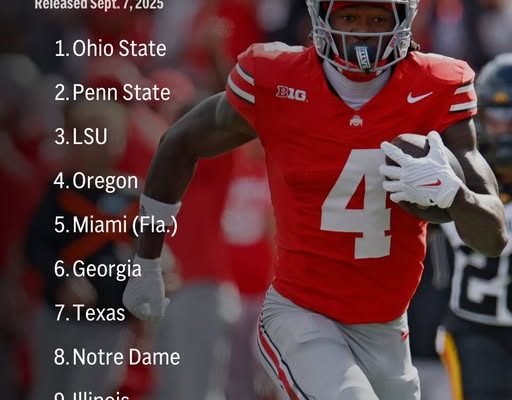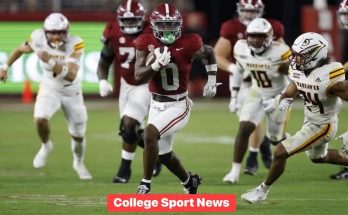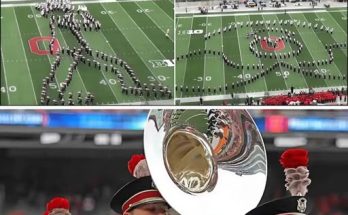Ohio State, Penn State, and LSU maintained their positions as the top three teams in The Associated Press Top 25 college football poll on Sunday, reflecting a combination of continued dominance and consistent performance in the early weeks of the 2025 season. The latest rankings saw little movement among the elite programs, underscoring the stability at the top of the college football landscape. However, the poll did feature notable shifts among teams outside the top ten, as upsets, decisive victories, and emerging narratives shaped the perceptions of voters across the country.
Ohio State, holding the No. 1 spot, has continued to impress with a balance of high-powered offense and disciplined defense. The Buckeyes, under their current coaching staff, have leveraged an experienced quarterback and a deep roster to dominate opponents in the early season. Their offensive line has consistently provided protection, enabling their star quarterback to distribute the ball efficiently to a range of receiving options, while the running game has kept defenses honest. Ohio State’s defense, meanwhile, has been aggressive and opportunistic, generating turnovers at critical junctures in games and keeping opposing offenses from sustaining drives. This combination of offensive firepower and defensive resilience has solidified Ohio State’s reputation as the team to beat in 2025. The Buckeyes’ schedule, which has included challenging matchups against conference rivals, has only reinforced their top ranking, as they have handled adversity with poise and strategic execution. Voters have responded to this consistency, rewarding Ohio State with the top spot despite the pressures that come with maintaining a number-one ranking in college football.
Penn State, ranked second, has emerged as a formidable challenger to Ohio State, blending a dynamic offense with a disciplined approach on defense. The Nittany Lions have capitalized on their depth at skill positions, allowing them to rotate players without losing effectiveness on either side of the ball. Their quarterback has shown remarkable composure, connecting with both veteran and emerging receivers to sustain drives and convert crucial third downs. Penn State’s running game has been particularly effective in controlling the tempo of games, providing balance and preventing opposing defenses from focusing solely on the passing attack. Defensively, the Nittany Lions have excelled in both pass coverage and run-stopping, demonstrating versatility and adaptability that have been key to their success. The combination of these elements has made Penn State a legitimate contender and justified their second-place ranking, as voters recognize the team’s ability to challenge for a conference title and potentially compete for a national championship. Their remaining schedule presents tests against ranked opponents, and continued success against these teams will be critical for maintaining their high standing in future polls.
LSU, holding the third spot, has continued to impress with an explosive offense and a stout defense. The Tigers have featured a quarterback capable of making both quick reads and deep throws, complemented by a talented group of receivers who can create separation and make contested catches. LSU’s offensive line has played a critical role, allowing the passing game to flourish while establishing a powerful running attack that keeps defenses off balance. On the defensive side, LSU has showcased a relentless pass rush and disciplined secondary coverage, often forcing turnovers and creating momentum-changing plays. The Tigers’ performance has been particularly notable against non-conference opponents, where their ability to dominate across all phases of the game has sent a strong message to poll voters about their capabilities. LSU’s placement at No. 3 reflects both their talent and their consistency, as they continue to position themselves as a top contender in the Southeastern Conference and a team with legitimate national championship aspirations.
While the top three remained unchanged, the most significant movements in the AP Top 25 occurred outside the top ten, highlighting the volatility and excitement that have defined the early portion of the season. Teams that have historically hovered in the middle tiers of the rankings have experienced substantial rises or falls, often driven by single games that either showcased their potential or exposed vulnerabilities. For example, a previously unranked team achieving a dominant victory over a top-tier opponent often results in a sharp ascent, as voters reassess their strength and overall season outlook. Conversely, teams with early-season losses or inconsistent performances have been subject to steep drops, reflecting the high stakes and competitive balance of college football. These shifts illustrate the dynamic nature of the sport, where a few pivotal plays or unexpected results can dramatically alter national perceptions and influence postseason positioning.
Among the notable movers, several teams outside the top ten have risen due to commanding victories and impressive statistical performances. These teams have combined efficient offensive execution with opportunistic defense, often exploiting weaknesses in opponents’ schemes and capitalizing on turnovers. Voters have taken note of such performances, rewarding teams that demonstrate not only talent but also discipline, coaching acumen, and the ability to execute under pressure. These rising programs represent potential dark horses for conference titles and playoff consideration, adding intrigue and excitement to the latter stages of the season. Conversely, some programs that began the season with high expectations have struggled to maintain momentum, experiencing losses that have caused them to slide down the rankings. Factors such as injuries, underperformance at key positions, or simply facing superior opponents have contributed to these declines, illustrating the thin margin between success and disappointment in college football.
Another compelling aspect of the current AP Top 25 is the emergence of teams from non-traditional power conferences. These programs have achieved victories over higher-ranked opponents, forcing voters to recognize their competitiveness and adjust rankings accordingly. Their success highlights the growing parity in college football, where preparation, strategy, and execution can overcome historical prestige. These teams bring added intrigue to the season, as they can influence conference standings, disrupt playoff projections, and challenge assumptions about which programs are capable of competing at the highest level. Their performance underscores the depth of talent across the sport and suggests that future polls may see continued movement as these programs establish themselves as legitimate contenders.
In addition to on-field performance, narratives surrounding individual players and coaching staffs have also influenced the latest rankings. Teams featuring standout quarterbacks, elite defensive linemen, or versatile playmakers have often seen their stock rise, as voters weigh the impact of these athletes on the overall success of their programs. Similarly, coaching decisions, such as strategic adjustments, halftime adjustments, and innovative schemes, have been recognized as factors that contribute to a team’s effectiveness and consistency. The combination of player talent, coaching acumen, and team cohesion has become a critical consideration for voters when assessing rankings, particularly among teams outside the traditional power structure. These elements add a human dimension to the rankings, reflecting both the statistical achievements and the intangible qualities that make college football uniquely compelling.
While Ohio State, Penn State, and LSU occupy the top three positions, the remainder of the top 25 reflects a mixture of established programs, rising challengers, and teams seeking to reclaim past glory. Programs like Alabama, Georgia, and Michigan, historically dominant in their conferences, continue to occupy high-ranking positions but have faced challenges that prevent them from displacing the current top three. Meanwhile, mid-tier programs that have demonstrated resilience, adaptability, and skillful execution have gained recognition, moving into higher spots and signaling their potential to disrupt the status quo. These dynamics ensure that the rankings remain fluid, with each week’s results capable of significantly impacting national perceptions and postseason opportunities. The interplay between consistent top performers and ascending challengers makes the AP Top 25 a compelling narrative that captures the attention of fans, media, and analysts alike.
The current AP poll also underscores the importance of scheduling and conference play in shaping national perceptions. Teams that face and defeat highly ranked conference opponents often see their stock rise, while those that encounter setbacks against weaker competition may face criticism or ranking drops. This structure reinforces the significance of strategic scheduling, preparation, and adaptability, as each game carries weight in the overall assessment of a program’s strength. For teams on the rise, victories over established programs provide validation and momentum, while losses to lesser opponents can derail playoff aspirations and damage confidence. The strategic management of these matchups, combined with consistent performance, remains central to success in the hyper-competitive landscape of college football.
Additionally, the AP Top 25 serves as a reflection of both quantitative metrics and qualitative assessment. Voters consider win-loss records, strength of schedule, margin of victory, and statistical dominance, but they also factor in intangibles such as team cohesion, resilience under pressure, and the ability to execute in critical moments. This blend of objective and subjective evaluation ensures that rankings are both a measure of performance and a narrative of perception, capturing the multifaceted nature of the sport. The current poll illustrates how these considerations interact, as teams with compelling narratives, standout performers, and sustained success are rewarded alongside those achieving statistically impressive results.
Looking ahead, the remainder of the 2025 college football season promises continued movement and excitement within the AP Top 25. Ohio State, Penn State, and LSU will be tested by conference play, rivalries, and high-stakes matchups that could influence their national championship aspirations. Meanwhile, teams outside the top ten will continue to vie for recognition, seeking victories that solidify their standing and position them for postseason opportunities. Injuries, breakout performances, and strategic adjustments will further shape the landscape, ensuring that no ranking is permanent and that each week carries significant implications for the national narrative. Fans, analysts, and voters will remain engaged, scrutinizing results, evaluating performances, and anticipating the emergence of new contenders.



